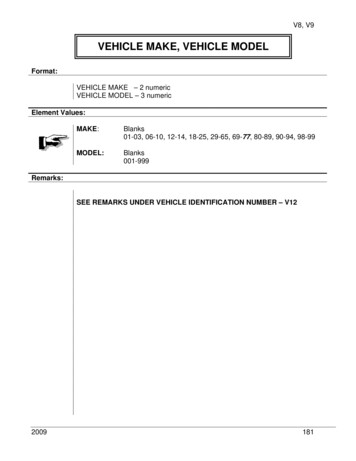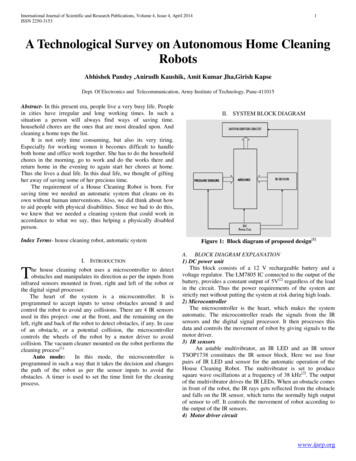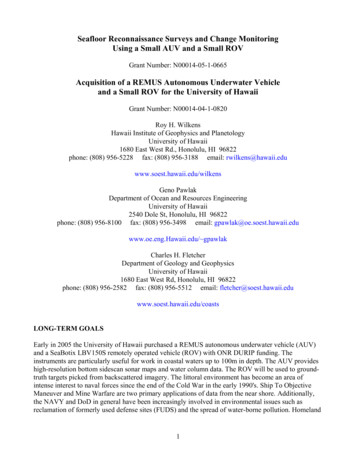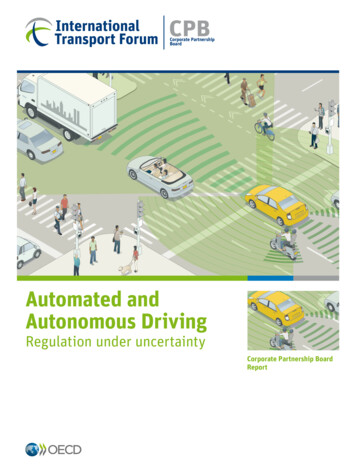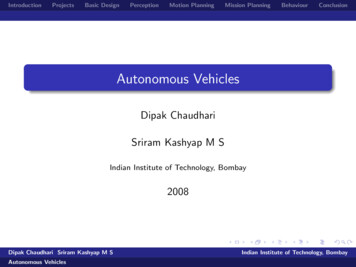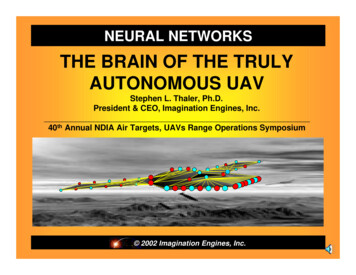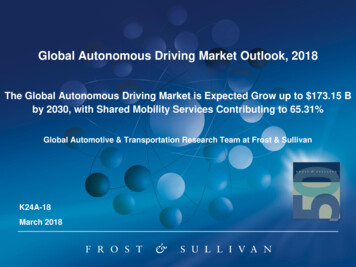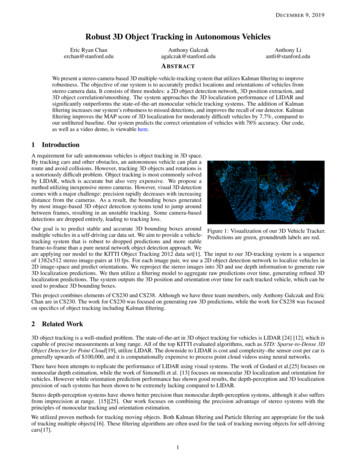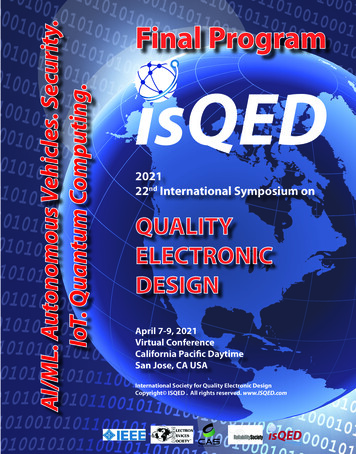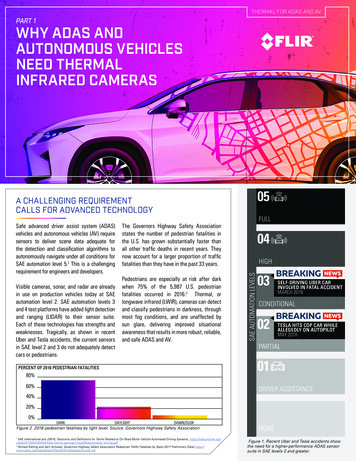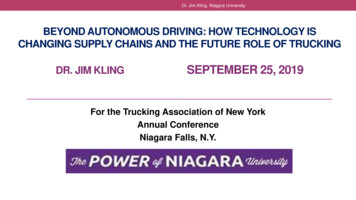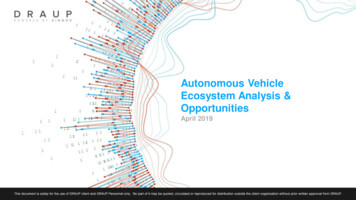
Transcription
Autonomous VehicleEcosystem Analysis &OpportunitiesApril 20191Source : DRAUP1
AGENDA0102Autonomous Vehicle OverviewTechnology Spend Analysis03Autonomous Vehicle Adoption04Bay Area–Deep Dive05Top Companies Deep Dive06Partnership OpportunitiesThis section provides an overview of : Autonomous vehicle overview and itspotential Disruption in Autonomous Vehicles:o Tech Giantso Partnerships & Consortiumso Acquisitions & Start-ups Impact of AV on different industries Future of AV Growth Drivers of AV New Emerging business models2
Overview: Autonomous Vehicles (AV) have huge potential to impact global economies, marketsand industries 7 TrillionPotential savings in the areas of fuel efficiency, cost of life and productivitygains enabled through AV based business models in US by 2025 250 BillionEstimated worth of Autonomous Vehicle Industry by 20253 MillionPotential Job loss in US by 202517%Expected AV market share as percentage of total worth of Auto industry, in 20258 MillionEstimated Level 3 and higher AV by 2025Note : DRAUP- The platform tracks engineering insights in the automotive ecosystem using our proprietary machine learning algorithms along with human curation. Theplatform is updated in real time and analysis is updated on a quarterly basis3Source : DRAUP3
Disruption in AV: Penetration of Tech giants in AV space has created an intense competition fortraditional automotive players that enables multiple disruptions in the ecosystemDisruption in AV123Tech GiantsPenetrationin AVConsortium &PartnershipsAcquisitions ofStart-upsTech giants are penetrating the AV ecosystem due to itsprominent potential and impact. Tech giants areinvesting with OEMs, Tier-1 suppliers and start-ups tooffer services and solutionsAutonomous vehicle development has disrupted thetraditional partnership trends in auto industry and hasbrought in multiple industry giants together working inconsortiumsCase Studies Google’s Waymo, self driving vehicle technology company has partnered with Tier1 and OEMs like Magna, FCA, and Jaguar to offer full-stack autonomous vehicles. It is also setting up a factory in Detroit to build autonomous vehicles and is workingwith American Axle & Manufacturing to convert the existing factory Intel acquired Mobileye which develops computer vision and machine learning,data localization, localization and mapping for ADAS and autonomous driving. BMW collaborated with Intel and Mobileye to position itself in AV ecosystem.Followed by BMW, tier 1 suppliers and other OEMs like Delphi, Valeo, Magna,Toyota, Aptiv, Continental, Jaguar, and Audi have also joined the coalition.AV based ML and Sensor startups have attractedphenomenal investments from the giants who arelooking to win the Autonomous vehicle race GM acquired Cruise to use the technology and talent to accelerate the process ofdeveloping AV. GM Cruise is also partnering with other startups and companies todeploy autonomous vehicles. It has collaborated with DoorDash which offers fooddelivery service4Note : The platform tracks real time insights and developments in the Autonomous Vehicle Ecosystem such as global engineering footprint, product launch,Leadership Announcements, M&A, among other essential insightsAbove analysis is based on the DRAUP’s proprietary engineering database and insights from industry stakeholders, updated as on April, 2019Source : DRAUP4
Penetration of industries in AV: New age solution providers in the areas of Semicon giants,Telecom, Cloud, and Mobility are bolstering the evolution of vehicle autonomyAutomotive Ecosystem has been disrupted through digital mega innovationsEcosystem maturity trend during last 15 yearsTelecom: 5G InfrastructureInsurance Providers: Usage based InsuranceCloud Platforms: Data Management & SecurityNew Age Suppliers: ADAS Systems & ComponentsData Services: Connected CarInternetAgeMobility Services: Alternative OwnershipTech Mafia: Car OS, HMISiliconEvolutionConsumer Electronics: Infotainment OS9 Semiconductor giants such as Inteland Nvidia have developedspecialised SoCs for processingand computing large amount ofvehicle datasets Tech Mafia have transformed thevehicle into a software computingsystem with capabilities to takeautonomous decisions New age suppliers have builtcapability into Advanced vehiclecontrol using deep learning,sensor systems and connectivityservices The current Autonomous Vehicleecosystem has been rapidly growingthrough a rich infrastructure ofnetwork, cloud & insuranceproviders enabling new agebusiness models8765432Semiconductor Giants: SoC Processors1Automotive 1.0Traditional suppliers such asBosch and TomTom have enabledadvanced vehicle navigation andmonitoring through specialisedtelematics equipment10Number of players in the Automotive EcosystemSmartMobility Traditional Suppliers: Telematics equipment0Note: Each unit on Y-Axis represents asingle type of ecosystem player2003200620092012201552019Note: The timeline above is illustrative of landmark events in the autonomous vehicle ecosystem during the last 15 years. The list above is non exhaustiveDRAUP Engineering Module: The platform tracks real time insights and developments in the Autonomous Vehicle Ecosystem such as global engineering footprint, productlaunch, Leadership Announcements, M&A, among other essential insightsSource : DRAUP5
Future of AV: Companies are accelerating commercialization of level 3 & 4 autonomy to lead thetechnology raceTargeted Levels of automation by20212Fully automatedvehicleUber5FullAutomationBMWGeneral MotorsFordWaymo The league of 5 are wellpositioned and future-ready, basistheir current R&D investment orvia virtue of their acquisitionsand/or partnershipsDelphiHighway autopilotIncluding highwayConvoy Parkinggarage pilotHighway chauffeurTraffic jam chauffeurPartial automatedParking Traffic jamassistance4HighAutomationAppleAutolivPSAVolvo Argo.aiZoox AutomationBoschnuTonomy VolkswagenNissan-Renault Nvidia3ConditionalAutomationValeo alTeslaIntel GM, Ford, and Waymo havecommitted to attain Level 5automation capabilities whereasIntel, Tesla and Bosch haveenvisioned Level 4 automation by2021 These players have beenexploring a diverse set of GTMstrategies such as partnershipswith mobility providers, fleetmanagement and personalownership model to launch theirfirst commercial AutonomousVehicles by 20212021 AV Readiness Index16Note : 1-2021 AV Readiness Index: Function of % R&D Talent in Autonomous Vehicle technology, External Acquisitions and Investment, patents and partnerships;2- Function of current leadership Outlook and commitments for autonomous vehicle launch in 2021. Automation Levels as outlined by SAE updated as of 2019;The above analysis is based on the DRAUP’s proprietary engineering database and insights from industry stakeholders, updated as on April 2019Source : DRAUP6
AV Growth Drivers: Liberal government policies, technology advancement and ecosystemopenness to co-innovate are the key enablers driving autonomous vehicle innovations12Technology advancementDrivers forAutonomousVehicleDecline in cost of computing and advancementin processing power have enabled processinglarge volume and variety of data such as image,voice, text, etc.Advances in machine learning have allowedcomputer vision to compute unstructured dataand distinguish objects on the road and build 3-Dmaps of the surrounding areaDeep learning and artificial intelligence haveled to better algorithms for pedestrian detection,traffic control and other automation features.Political, legal and social driversState legislations related to autonomous vehicleshave gradually liberalised . In 2019, 29 stateshave introduced legislation related to autonomousvehicles in USA, allowing testing of autonomousfleets under certain specified conditionsExtensive government investment in keycountries- US and UK governments plan to invest 4Bn and 38Mn over the next 5 years, ondriverless cars technology3Open Ecosystem Collaborative and open innovation- Top player Teslaopen-sourced its patents while Baidu and Lyft haveopen software platforms Competitive landscape- Entrance of technologymafias which are building a competitive environment inAV through their strong capability in software platforms R&D partnerships between universities andautomakers- Toyota partnered with University ofMichigan for autonomous innovation.Projected 20% overall reduction in roadaccidents- Elimination of drivers is expected toreduce driving accidents caused by human error.Note: Autonomous Vehicle regulations have been verified from reports published by Department of Motor Vehicle, California and other state regulatory bodies in respective geographiesSource : DRAUPThe above analysis is based on the DRAUP’s proprietary engineering database and insights from industry stakeholders, updated as on Feb, 201877
New Business Models: Shared service model and fleet owned taxis would be the first level of AVintegration globallyService and public utilization based models to dominate while traditional ownership model to diminishBusiness lesIndividual Owned Shared ServiceModelsPrivately owned vehicles provideride hailing/sharing service whenowner is not currently using it.Uber, LyftFleet Owned TaxisService company operates fleet ofautonomous vehicles to providemobility servicesWaymo, NuTonomy, LyftVehicle LicensingConsumers pay owner for the useof vehicleCustomizable rental programsAV–enabled software packagesServices and software that unlockfull autonomous capabilitiesProductive software suitesRetrofitPackage of Hardware and Softwareto retrofit fully autonomouscapabilities on selected vehiclesComma OneIntensity of Autonomy8Note: Autonomous Vehicle models have been verified from reports published by Department of Motor Vehicle, California and other state regulatory bodies in respective geographies.Source : DRAUPThe above analysis is based on the DRAUP’s proprietary engineering database and insights from industry stakeholders, updated as on Feb, 20188
AGENDA01Autonomous Vehicle Overview02Technology Spend Analysis03Autonomous Vehicle Adoption04Bay Area–Deep Dive05Top Companies Deep Dive06Partnership OpportunitiesThis section provides an overview of : Technology Spend Analysis:o In-house Engineering Spendo External Technology Spend Engineering Spend Analysis:o Top Companieso Industryo Geographyo Technology Segments Geographical Talent Analysis AV Ecosystem Analysis and Top 25Companies mapping Analysis of acquisitions and investments bytop companies9
AV Technology Spend: AV ecosystem players are fuelling the technology spend by makinginvestment in-house or externally for faster development and deployment of AV capabilitiesAutonomous Vehicle In-house1engineering spend Engineering spend by autonomous vehicles includes inhouse investments like talent, solutions, platforms, andservices made by the OEMs, Tier-1suppleirs, tech giants toenhance the autonomous technologies for fasterdeployment of vehicles Major players investing in engineering spend include: Semicon giants, OEMs, tech giants are investing or acquiringin start-ups to leverage AV innovations. For example, Googleacquired Waze, GM acquired Cruise, Intel acquiredMobileye to develop AV solutions and capabilities Major players include acquiring or building consortiums: 10-11 BnEngineering spendglobally onautonomoustechnologies as of2018Total AV Technology Spendby top 25 players (2018): 32–34 BnAutonomous Vehicle External2technology spend 22-23 BnAV –Acquisition,Corporate VC Spend& Partnership as of201810Note: AV In-house Technology spend: includes salaries and compensation along with spend on software, platforms and hardware tools required to develop In-house capability;External Technology Spend: Consists of investment in Autonomous Vehicle and related technology areas through Acquisitions, Partnerships and Corporate Venture Arms;The above analysis is based on the DRAUP’s proprietary engineering database and insights from industry stakeholders, updated as on April 2019Source : DRAUP10
Engg Spend by Top Companies: Engineering spend by the top 5 players is largely focused ondeveloping full stack solutions, robust sensor systems and advanced computing platforms for vehiclecontrolKey InsightsAV In-house Engineering spending analysis (2018) 56% Majority of the in-house engineering spend by players isbeing invested in Autonomy. Top companies have alreadyinvested billions in development of autonomous vehicleslike Ford is investing 5.4 billion in driverless cars and GMhas already invested 1.5 billion. GM, Tesla, Ford, Waymo, and Uber are the top players inthe autonomous vehicles ecosystem and are highlyinvesting to deploy the AV. Companies like GM andWaymo are building R&D centres and assembly plants tobuild AV Primarily, the companies are focusing on ride-sharing anddelivery over individual ownerships. Top players are majorly focusing on Electric vehicle AV ascompared to gasoline EV due to less moving parts andmaintenance costsR&D spendby top 5players 10–11Bn 31%R&D spendby next 10playersIn-houseEngineeringSpend by top25 companies 13%R&D spendby next 10players11Note: The numbers above are rounded-off, so they might not add up to 100%Note: 1-Technology spend includes employee compensation and related expenses along with spend on software, platforms and hardware tools required to develop In-housecapability; The above analysis is based on the DRAUP’s proprietary engineering database and insights from industry stakeholders, updated as on April 2019Source : DRAUP11
AV In-house Engg Spend by Industry: Tech Mafia and the Semiconductor giants are spending heavilyalongside Automakers to develop strong Autonomous Vehicle capabilityAV In-house Engineering Spend by Industry Verticals (2018) 10–11BnOthers*Semiconductor giants such as Intel and Nvidia havedeveloped specialised Autonomous Vehicle SoCsfor processing and computing using ML algorithms Tech Mafia giants are differentiating through strongAI capability leveraging deep learning algorithmsrequired to make advanced driving systems safeand predictable Tier-1 suppliers such as Bosch, Delphi andContinental are major players providing SensorSystems such as Lidar, Radar, Cameras, andUltrasonic sensors Full stack ADAS providers is the most fundedsegment . Nauto, Argo AI and Drive.ai are the topplayers investing in full stack-Autonomous Vehiclesolutions14-16%SemiconductorAutomotive Start-ups 25-27%Tech MafiaTier-1 SuppliersOEMs have strategic focus on developing criticalsafety and driving systems in-house. OEMs suchas Daimler, BMW and Ford are establishingpartnerships with technology providers tocollaboratively develop software capability for visionand perception systems34-36%Traditional OEMsIn-houseEngineeringspend1 on AV as of2018 10-12%7-8% 5%Note: The numbers above are rounded-off, so they might not add up to 100%12Others* include Telecom, Data Services, Insurance and other AV related infrastructure providersNote: 1 Include investments on In-house R&D spend on engineering salaries and infrastructure support in AV and related technology areas;DRAUP Engineering Module – Include AV companies across major geographies such as US, Canada, Israel, Europe, China and India.Coverage may be limited in China and other south east APAC regionsSource : DRAUP12
AV In-house Engg spend by geography: Majority of engineering investment in AV ecosystem isconsolidated in US due to the supporting regulations by NHTSAUSD 10-11 BnGlobal AV In-house Engineering Spend by Top 25 players (2018)Investment focus by Geography OEMs, Tech giants, Tier-1 providershave chosen US, UK, Germany,China and India as major hotspotsfor engineering centres 30% 49%Europe 21%AmericasAPAC Majority of the players are focusingin US for the development of AVsolutions due to support from theNHTSA and technologicaladvancement. US have alsointroduced regulations for self-drivingvehicles on public roads and issuedautonomous testing permits.California has allowed operation offully autonomous vehicles with nodriver on public roads Autonomous Vehicles spend inAPAC region is growing due to highautonomy activities by Chineseplayers like Baidu and SAIC.Shanghai has issued its first selfdriving licenses in China13Note: Geographical split indicates only the prime Autonomous Vehicle R&D locations. Primary locations include US, Europe, India and China; The above analysis is based on theDRAUP’s proprietary engineering database and insights from industry stakeholders, updated as on April 2019Source : DRAUP13
Geographical Talent Split: While the AV talent footprint is distributed across global locations, US andEurope are the hotspots with nearly 60% of talent consolidated between these two regionsGeographical split by AV Engineering HeadcountUSA 47%EuropeGlobal Autonomous VehicleEngineering HeadcountChina40,000–45,000UK 15% 13% 9%Israel 7%CanadaSingapore 6% 3%14Note: The numbers above are estimated R&D headcounts in respective locations updated as of 4th quarter of financial year 2018Note: Geographical split indicates only the prime Autonomous Vehicle R&D locations. Primary locations include US, Germany, France, Canada, China, UK, and Singapore ; Theabove analysis is based on the DRAUP’s proprietary engineering database and insights from industry stakeholders, updated as on April 2019Source : DRAUP14
In-house Engg Spend by Technology Segments: R&D is focussed on developing core softwarecapabilities, leveraging deep learning for computing, vehicle control and vision-based perceptionTotal AV EngineeringSpend1USD 10-11 BnTechnology Segments3D Mapping/ Localization11 %Vision based perception24 %HMI/ UI-UX10 %Computing & Vehicle Control30 %Sensors20 %Network, Connectivity & Security5%INSIGHTSHigh resolution HD Maps enable precise lateral andlongitudinal positioning for vehicle localizationComputer Vision systems use advanced deep learningto aggregate, classify and identify criticalenvironment data such as obstacles, pedestrians, trafficsigns etc.HMI is crucial to optimally support the driver in themonitoring and remotely control autonomous cars andto give access to live sensor data and useful data aboutthe car state, such as current speed, engine and gear stateUsing Neural Networks, the vehicle brain analyses allsensor input and operates steering, accelerator andbrakes for critical driving decisions such as collisionwarning, cruise control and advanced safetyLidar, Radar, Odometry and Ultrasonic sensorsystems for lane centering, path planning and V2VcommunicationsAdvanced vehicle connectivity infrastructure to enablecommunication between vehicles and environment(V2V, V2X)Note: 1-Technology spend includes employee compensation and related expenses along with spend on software, platforms and hardware tools required to develop In-housecapability; The above analysis is based on the DRAUP’s proprietary engineering database and insights from industry stakeholders, updated as on April 2019Source : DRAUP1515
AV Ecosystem: Two type of organisations are accelerating Autonomous Vehicle Ecosystem In-house Innovators vs Collaborative Developers1Autonomous Vehicle Capability & Investment AnalysisTechnology Maturity Index 2 --------- High1In-house InnovatorsCollaborative DevelopersZoox AutomationTeslaGoogle- olivVolvoVolkswagenFordToyotaDelphiPSA Start-ups and Tech Mafias havebeen investing in AutonomousVehicle platforms and VehicleOperating Systems, leveraging theirstrong software capability Key technology focus areas ofthese companies are Deeplearning for vehicle control andComputer Vision for environmentperception and sensingIntelBaidu DaimlerIn-house InnovatorsAppleBosch2Nissan-Renault Semiconductor giants such asIntel and OEMs such as BMW,Toyota and GM have establishedstrong consortium to co-innovateNvidiaContinentalLowHighInorganic Growth Index1 --------- Total R&D head
Followed by BMW, tier 1 suppliers and other OEMs like Delphi, Valeo, Magna, Toyota, Aptiv, Continental, Jaguar, and Audi have also joined the coalition. Google’s Waymo, self driving vehicle technology company has partnered with Tier-1 and OEMs like Magna,
